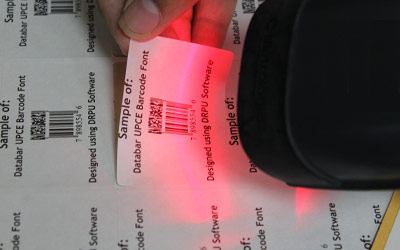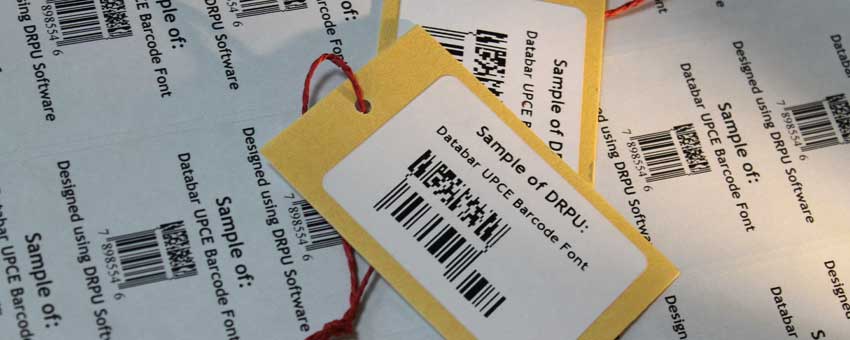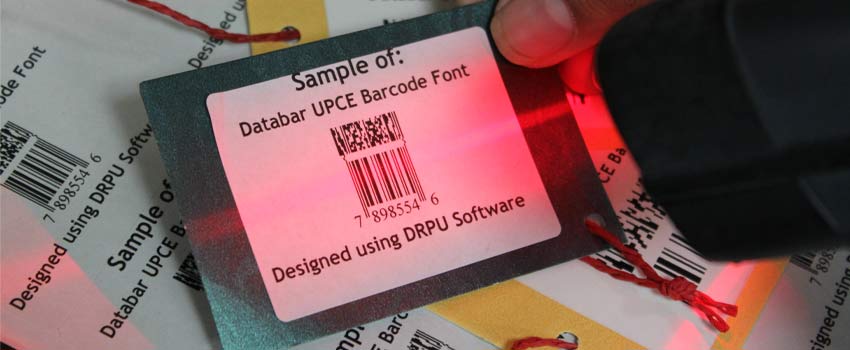
Decoding a Databar UPCE barcode is a relatively straightforward process that involves the use of a barcode scanner or a smartphone app. In this section, we will explore the process of decoding a Databar UPCE barcode, including the information that is encoded in the barcode and the tools that are required to read and decode the barcode.
➠Decoding a Databar UPCE barcode requires the use of a barcode scanner or a smartphone app that can read barcodes. Barcode scanners are specialized devices that are designed to read and decode barcodes, while smartphone apps can use the camera on a smartphone to scan and decode barcodes. Some popular barcode scanning apps include Barcode Scanner, ScanLife Barcode Reader, and RedLaser Barcode Scanner.
➜The process of decoding a Databar UPCE barcode involves the following steps:
-
Identify the Barcode
The first step in decoding a Databar UPCE barcode is to identify the barcode. The barcode will typically be located on the product packaging or label, and it will be a series of vertical bars and spaces that encode product information.
-
Align the Barcode
Once the barcode has been located, the next step is to align the barcode with the barcode scanner or smartphone camera. The barcode scanner or smartphone app should be positioned directly over the barcode, and the barcode should be well-lit and free from any obstructions.
-
Scan the Barcode
With the barcode aligned and in focus, the next step is to scan the barcode using the barcode scanner or smartphone app. The scanner or app will capture an image of the barcode, and it will use special software to decode the information that is encoded in the barcode.
-
Decode the Barcode
Once the barcode has been scanned, the information that is encoded in the barcode can be decoded. The information that is encoded in the barcode will typically include the manufacturer, product number, and price, as well as any other relevant product information.
-
Verify the Information
Finally, it is important to verify that the information that has been decoded from the barcode is correct. This can be done by comparing the decoded information to the information that is printed on the product packaging or label. Any discrepancies should be addressed and corrected to ensure that the product information is accurate and up-to-date.
✍Note:- Decoding a Databar UPCE barcode is a simple process that can be accomplished using a barcode scanner or smartphone app. By scanning and decoding the barcode, businesses can quickly and accurately identify and track individual products, monitor inventory levels, and ensure pricing accuracy. By verifying the information that is encoded in the barcode, businesses can also ensure that product information is accurate and up-to-date, which can help to improve customer satisfaction and loyalty.
Reading of Databar UPCE Barcode by Scanners
The Databar UPCE barcode is a type of linear barcode that is commonly used in the retail industry to encode product information, including the manufacturer, product number, and price. Barcode scanners are used to read these barcodes, and the information encoded in the barcode can be used for inventory tracking, product information management, and other purposes. In this section, we will explore the compatibility of Databar UPCE barcodes with different types of barcode scanners.
-
Barcode Scanner Compatibility
The Databar UPCE barcode is a standardized barcode that is recognized by most barcode scanners on the market today. In general, any barcode scanner that is capable of reading UPC barcodes will also be able to read Databar UPCE barcodes, as the two barcodes are closely related. However, there are some factors that can affect the compatibility of Databar UPCE barcodes with different types of barcode scanners, including the scanning technology used by the scanner, the orientation and position of the barcode, and the quality of the barcode image.
-
Scanning Technology
Barcode scanners use different types of scanning technology to read barcodes, including laser, CCD (charge-coupled device), and camera-based scanners. Each type of scanner has its own strengths and weaknesses, and some scanners may be better suited for reading Databar UPCE barcodes than others. In general, laser scanners are the most common type of barcode scanner, and they are capable of reading Databar UPCE barcodes as well as other types of linear barcodes. CCD scanners are also capable of reading Databar UPCE barcodes, but they may have difficulty with poorly printed or damaged barcodes. Camera-based scanners are the most versatile type of scanner, and they can read both linear and 2D barcodes, including Databar UPCE barcodes.
-
Orientation and Position
The orientation and position of the Databar UPCE barcode can also affect the compatibility of the barcode with different types of barcode scanners. In general, the barcode should be positioned vertically on the product or label, with the bars running from left to right. The barcode should also be placed in an area that is easily visible and accessible to the barcode scanner. If the barcode is placed at an angle or is difficult to access, some barcode scanners may have difficulty reading the barcode.
-
Barcode Quality
The quality of the barcode image can also affect the compatibility of the Databar UPCE barcode with different types of barcode scanners. In general, the barcode should be printed clearly and accurately, with the correct size and spacing of the barcode modules. The barcode should also be free of smudges, stains, or other marks that could interfere with the barcode scanner's ability to read the barcode. If the barcode is poorly printed or damaged, some barcode scanners may have difficulty reading the barcode.
In conclusion, the Databar UPCE barcode is a standardized barcode that is recognized by most barcode scanners on the market today. Barcode scanners use different types of scanning technology, and some scanners may be better suited for reading Databar UPCE barcodes than others. The orientation and position of the barcode can also affect the compatibility of the barcode with different types of barcode scanners, and the quality of the barcode image is also an important factor to consider. By ensuring that the barcode is printed clearly and accurately and is positioned in an easily accessible location, businesses can improve the compatibility of the Databar UPCE barcode with different types of barcode scanners, which can help to improve inventory tracking and product information management.
Limitations of Using Databar UPCE Barcodes
While Databar UPCE barcodes offer many advantages, there are also some limitations to their use. In this section, we will explore some of the limitations of using Databar UPCE barcodes.
-
Limited Data Capacity
One of the limitations of using Databar UPCE barcodes is their limited data capacity. Compared to other types of barcodes, such as QR codes, Databar UPCE barcodes can only store a limited amount of data. This is because they are a linear barcode, which means that the information is encoded in a series of bars and spaces that can only be read in a linear fashion. As a result, Databar UPCE barcodes are typically used to encode basic product information, such as the product number, manufacturer, and price. They are not suitable for encoding more complex product information, such as product descriptions or images.
-
Requires Line of Sight
Another limitation of Databar UPCE barcodes is that they require a clear line of sight to be read. Barcode scanners need to be able to see the barcode in order to read it, which means that the barcode must be visible and not obstructed in any way. This can be a problem if the barcode is located in a hard-to-reach or difficult-to-see location, such as on the bottom of a product or behind a shelf. In these cases, it may be necessary to move the product or use a handheld scanner to read the barcode.
-
Printing Quality
The printing quality of Databar UPCE barcodes is also an important consideration. In order to be read accurately, the bars and spaces of the barcode must be printed at a high resolution and with high contrast. If the barcode is printed poorly or on a low-quality printer, it may not be readable by barcode scanners. This can lead to errors and inaccuracies in inventory management and supply chain operations.
-
Limited Application
Another limitation of Databar UPCE barcodes is their limited application. While they are widely used in the retail industry for encoding product information, they are not suitable for all applications. For example, Databar UPCE barcodes are not suitable for tracking assets or equipment, as they do not provide enough information to identify a specific asset. In these cases, other types of barcodes, such as QR codes or Data Matrix codes, may be more suitable.
-
Lack of Security Features
Finally, Databar UPCE barcodes do not have any built-in security features. Unlike QR codes or Data Matrix codes, which can be encrypted or password-protected, Databar UPCE barcodes do not provide any protection against counterfeiting or tampering. This can be a problem in industries where security is a concern, such as in the pharmaceutical or military industries.
In conclusion, while Databar UPCE barcodes offer many advantages, there are also some limitations to their use. These include limited data capacity, the need for a clear line of sight, printing quality, limited application, and the lack of security features. Businesses that are considering using Databar UPCE barcodes should carefully consider these limitations and weigh them against the advantages of using this type of barcode. They should also consider the specific needs of their business and industry, and whether Databar UPCE barcodes are the most suitable type of barcode for their applications.

